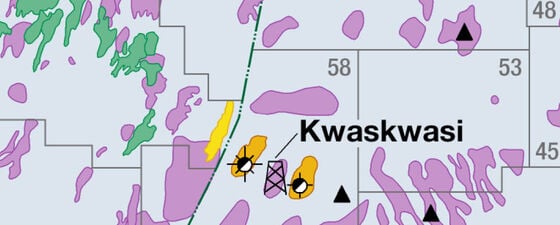Following the trend and showing that the Canje source kitchen does not stop at borders.
The proposed Kwaskwasi well lies between the Maka Central discovery to the north-west and Sapakara to the south-east.
Operator Apache and partner Total are two-for-two on Block 58 Suriname with the Sapakara West discovery, and have now spudded their third consecutive well on trend, Kwaskwasi-1. This follows on the country – and company – maker Maka Central discovery and extends the prolific ‘Liza’ trend southeast from Guyana into deepwater Suriname, where Upper Cretaceous clastics are stacked and nestled up against the greater Demerara High. Likely winners on the back of this could be nearby interest-holders Petronas, Cepsa, Kosmos, Chevron and Hess, as the Upper Cretaceous trend, along with the Canje source kitchen, appears to sweep along the eastern edge of Blocks 53 and 48 against the high. The southern extension will also be of great importance as the national oil company, Staatsolie, plan a bid round in this open acreage later in 2020.
Long Road to Success
Exploration began onshore Suriname in the early 1940s. In 1965 the Geological and Mining Service discovered shallow heavy oil at the Calcutta and Tambaredjo fields, where some 109 MMbo has been produced onshore from Palaeocene and Eocene reservoirs over the last 40 years. Approximately 40 wildcats have been drilled onshore and offshore Suriname since then, almost half with shows (see GEO ExPro Vol. 10, No. 4, 2013), but only now has this resulted in a major discovery offshore.
The Sapakara West discovery reached TD at 6,300m in 1,400m water depth, encountering 79m oil and gas condensate pay in the Campanian – 13m of gas condensate, with 30m of API 35–40° oil pay – and a 36m oil leg (API 40-45°) in the Santonian. The initial discovery made in January to the north-west, Maka Central-1, encountered 50m light oil and gas condensate in Campanian sands and 73m oil in the Upper Cretaceous Santonian clastics. Both wells so far have found these good oil legs in the Santonian with lighter oil and gas condensate in the Campanian. The Turonian, a potential target at Maka Central but with TDs at over 6 km clearly beyond the limits of the drilling engineers in this block, is not mentioned at Sapakara West.
Neither is the source interval alluded to, but Staatsolie and various authors place an oil mature TOC-rich marine source rock of the Canje Formation, variably described as Cenomanian Turonian and Albian to Santonian, in the heart of the Block 58 area. Other source rock intervals are thought to exist; Palaeocene heavy oils are found onshore, for example, and the Jurassic may host lacustrine, lagoonal or algal source facies.
Some regional maps show a north-west to south-east Jurassic graben running through the area. Apache report the Sapakara fan system target is separate from the reservoir fan at Maka Central, suggesting a cluster of larger discoveries is possible.
Follow-on Potential
Apache and Total now plan to make strides with two further wells, proposing to drill Kwaskwasi between Maka Central and Sapakara West, to be followed by a fourth well, Keskesi, about 20 km south-east of Sapakara West to test the limits of this kitchen.
Other significant wells to look out for: Kosmos, with Chevron and Hess, have Aurora and Walker planned in Block 42, while Tullow, with Ratio and Pluspetrol, are targeting Goliathberg in Block 47 and Tullow may also test Block 54. Petronas intend drilling the Sloanea-1 well in the third quarter of 2020 in Block 52, probably the closest to this play: ExxonMobil recently farmed-in to this block for 50% WI. Apache may or may not be drawing up plans for drilling in the adjacent Block 53 with partners Petronas and Cepsa, having drilled Kolibrie and Popokai there between 2015 and 2017, which only resulted in shows.
Don’t Stop at Discovering
Whilst this is an expensive deepwater wildcat campaign for Apache in these straitened times, the US firm does benefit greatly from the advantageous terms secured from Total when the French giant took a 50% piece of the action as Maka Central was approaching the top of the reservoir. The French major paid $100 million to get a seat at the table, with promises of imminent help with development costs as well, clearly hoping to repeat the astonishing success of ExxonMobil, Hess and CNOOC, which together managed to mobilise the first of four 2 MMbo FPSOs within just two years of discovering light oil on Starbroek in neighbouring Guyana. Apache will operate the first three wells on Block 58 before transferring operatorship to Total. Total will also pay all development-related expenses up to the first $5 billion and 25% of Apache’s expenses afterwards, up to the first $7.5 billion total development capex on the block; both companies will then fund 50% of the exploration and development costs. No acreage relinquishments are required until mid-2026.
A game changer for Suriname, these high volume, high productivity deepwater developments can provide great returns to all stakeholders at relatively low oil prices.





